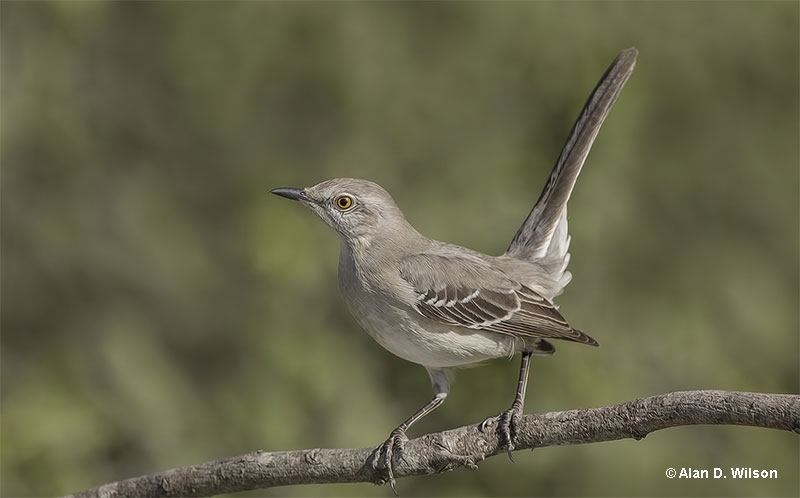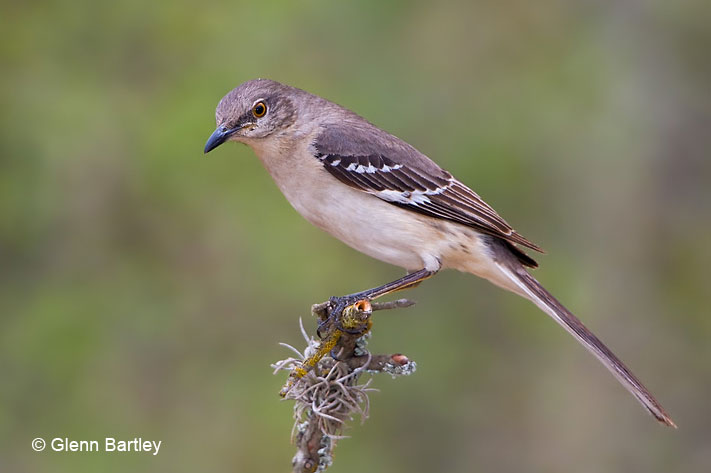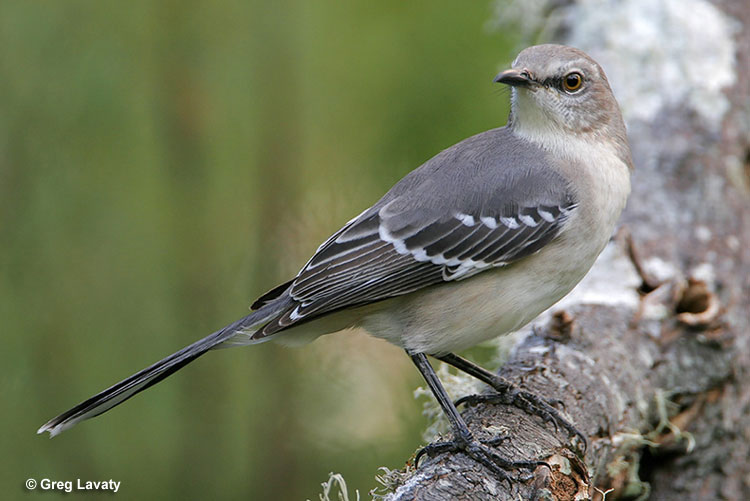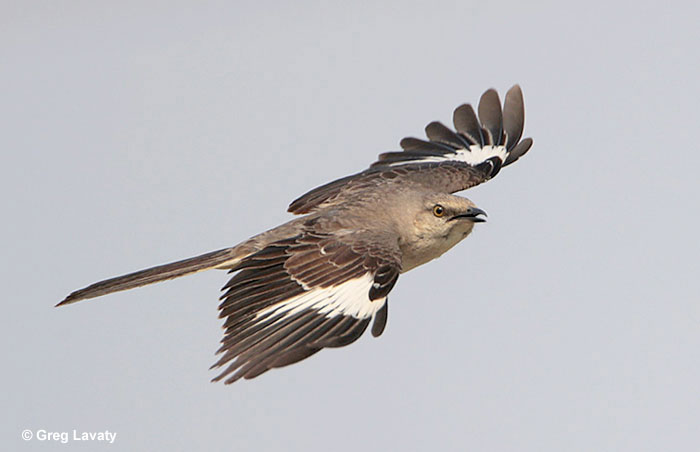
Mississippi is a southern, medium-sized state with a population of 2,964,000. This state has 48,430 square miles of farms, meandering rivers, marshes, cypress swamps, and woodlands. More than 420 bird species have been seen in these and other habitats in Mississippi.
One of those species is also the official state bird of Mississippi; the Northern Mockingbird. This slender, pale gray bird with a long tail and white wing patches is common and conspicuous. It forages on lawns and sings its complex and beautiful songs throughout the state.
On this page
Mississippi State Bird
The Northern Mockingbird became the official state bird of Mississippi on February 23, 1944. Similar to campaigns carried out by women’s clubs in other states, the Women’s Federated Clubs of Mississippi also pushed for their state to choose an official bird.
Starting in 1940s, they chose the Northern Mockingbird to represent Mississippi and campaigned for the state to take official action to declare it as the state bird.
Their campaigning paid off when the state legislature of Mississippi introduced a bill to officially name this species as the state bird in early 1944. The governor at the time quickly signed the bill and the Northern Mockingbird became the official bird of Mississippi.
This pleasant bird species was chosen because it is common and easily seen throughout the state. In addition, the beautiful songs of Northern Mockingbirds have impressed and soothed people in Mississippi for generations. Mockingbirds are such a regular part of life in Mississippi, even folks who don’t watch birds can’t help but notice them.
Northern Mockingbirds aren’t shy and like to forage on open lawns and sing from the tops of signs, houses, and other conspicuous spots. They are especially common in small towns, on farms, and often live close to houses.

Fun Facts about Northern Mockingbirds
- The Northern Mockingbird is an incredible mimic. This impressive bird can mimic the sounds of dozens, maybe even hundreds of other bird species. Some individuals have more than 200 different types of songs. These can include vocalizations of wrens, woodpeckers, chickadees, many other bird species, and mechanical sounds. One study also discovered that mockingbirds can mimic twelve species of frogs and toads!
- Northern Mockingbirds are intelligent birds. In 2009, a study discovered that they can recognize people’s faces, especially folks perceived to be a threat or intruder.
- Northern Mockingbirds are famous. This popular species has been featured in songs, movies, and folklore. They are usually depicted as symbols of innocence.
- The Northern Mockingbird is the state bird of 5 states. In addition to Mississippi, it is also the state bird of Arkansas, Florida, Tennessee, and Texas. In Texas, this bird was partly chosen because, “like any true Texas”, it fights for the protection of its home.
- Historically, the Northern Mockingbird only lived in southern states. This adaptable bird expanded north after the Asian Multiflora Rose was introduced to the USA. As the rose grew in more places, the plant provided more food and nesting sites for Northern Mockingbirds.
- This species used to be a valuable pet. During the 1800s, before the practice became illegal, hundreds of mockingbirds were captured, put in cages, and traded for large sums of money. They were valued as cage birds for their vocal prowess.
- Northern Mockingbirds nest several times in one breeding season. This species can nest seven times in one summer!
- Northern Mockingbirds also sing at night. On moonlit nights, males lacking mates can sing for hours in the middle of the night.
- Female Northern Mockingbirds also sing. Although they don’t sing as much or as loud as males, in fall, female mockingbirds sing quiet songs to establish winter territories.
Identification
The Northern Mockingbird is a slender, gray and white bird around the same size as an American Robin. It is gray above and white and buff below, has a blackish tail with white in the outer tail feathers, and a small, blackish beak.
This species also has two small white crescents above and below its pale eyes and a dark line on its face. The bird’s blackish, rounded wings have two white wing bars and a prominent white patch.
These white patches are especially visible in flight and when Northern Mockingbirds stand and hold their wings open.

Male and females look alike, but males are slightly heavier. This difference is impossible to see in the field, but juveniles look noticeably different. Young mockingbirds have pale brown highlights with some spotting on the underparts.
Related: Birds that start with N
Northern Mockingbirds are easily told from other birds by their pale gray head and plumage, long tail with white highlights, and white wing patches.
What Do Northern Mockingbirds Eat?
Northern Mockingbirds eat a wide variety of insects, berries, and other small fruits. They forage for insects in open areas with short grass such as lawns, parks, and golf courses. This species catches beetles, crickets, and other bugs by walking on the ground and then stopping to snatch the insect with its beak.
Mockingbirds can also fly up into the air and catch insects in flight. When feeding on berries, they perch in a bush or bush and pick food from the vegetation. Although they will eat berries during the summer months, they mostly eat fruit during the winter.
Call
The Northern Mockingbird has a complex and melodious song. It sings phrases of trilled and warbling sounds, and often incorporates the calls and songs of other birds.
Although they are excellent mimics, when we hear mimicked calls repeated several times, we know we are listening to a Northern Mockingbird.
They can mimic many species and other sounds. Some of the more commonly mimicked species include Blue Jays, Eastern Kingbirds, Killdeers, and Red-shouldered Hawk.
These songs can go on for several minutes or even longer and birds can sing any time of the day. Males sometimes also sing at night.
Mockingbirds also make dry “check” calls and nasal rasping vocalizations.
Behavior
The Northern Mockingbird spends much of its time foraging on the ground, singing, and driving off competitors and threats.
While foraging, it usually walks on the ground with its tail cocked up a bit and frequently holds its wings open. It might do this as a territorial display as well as to scare insects out of hiding.
These bold birds sing from elevated perches, often vocalizing form the top of a house, post, or other prominent spot. Sometimes, they also fly into the air while singing, especially at night.

Northern Mockingbirds are very aggressive in defense of their nest and their food sources. Near their nest, a pair won’t hesitate to harass hawks, snakes, and other potential predators. They also chase other birds away from their food, especially at fruiting bushes.
This species is not a threat to people nor our pets. Cooper’s Hawks, Raccoons, snakes, and other animals prey on Northern Mockingbirds, especially on nestlings.
Other Popular Birds In Mississippi
According to breeding bird surveys and other observations, the following species are thirty of the most common and popular birds in Mississippi.
- Cliff Swallow – Often seen in migration above every habitat.
- Red-winged Blackbird – Seen in wetlands and brushy fields.
- Northern Cardinal – A bird of gardens and second growth, it also visits feeders.
- Indigo Bunting – A summer resident in second growth and forest edge.
- Mourning Dove – Seen in every habitat and visits feeders.
- American Crow – A noisy bird of towns and every habitat.
- Tufted Titmouse – Often heard and seen in woodlands, parks, gardens, and at the feeder.
- Blue Jay – A common bird of woodlands, parks, towns, and feeders.
- Red-bellied Woodpecker – A species of woodlands, parks, and towns, it can also visit feeders.
- Carolina Wren – A bird of woodlands and wooded gardens.
- Dickcissel – A summer resident in weedy fields.
- Northern Mockingbird – A very common species of towns, parks, and other open habitats.
- White-eyed Vireo – Often heard and seen during the summer in thickets and second growth.
- Barn Swallow – A summer resident of fields, farms, and other open habitats.
- Brown-headed Cowbird – This species occurs in every habitat, especially on farms.
- Yellow-breasted Chat– A vocal but reclusive summer resident in thick second growth.
- Red-eyed Vireo – A vocal summer resident in wooded areas.
- European Starling – A common species in urban areas, farms, and other open habitats.
- Summer Tanager – A summer resident of oak woodlands and other forested habitats.
- Wood Thrush – A forest species that migrates south for the winter.
- Yellow-billed Cuckoo – Often heard and seen in wooded areas from spring to fall.
- Blue-gray Gnatcatcher – A common bird of wooded habitats, it migrates south in fall.
- Great Egret – Often seen in a wide variety of wetland habitats.
- Carolina Chickadee – a common bird at feeders, parks, and other wooded places.
- Cattle Egret – Often found in open habitats with cows.
- Eastern Towhee – A species of second-growth and forest edge.
- Acadian Flycatcher – This summer resident lives in forest habitats.
- Great Crested Flycatcher – This bird occurs in wooded areas and parks from spring to fall.
- Eastern Wood-Pewee – A common summer resident in a variety of wooded habitats.
- Purple Martin – This big swallow species is present from spring to fall in places with martin nesting boxes.
Read more: Most Common Birds of MS
Frequently Asked Questions
How many bird species are in Mississippi?
There are 429 bird species have been found in Mississippi.
What is the rarest bird in Mississippi?
The Ivory-billed Woodpecker used to be the rarest bird in Mississippi. However, this species no longer occurs in the state and may be extinct. Other, more recent sightings of rare birds in Mississippi include the American Flamingo and the endangered Saltmarsh Sparrow.
What birds is Mississippi known for?
Mississippi is known for such birds as the Northern Mockingbird, Northern Bobwhite, Red-headed Woodpecker, Brown-headed Nuthatch, and Swainson’s Warbler.

